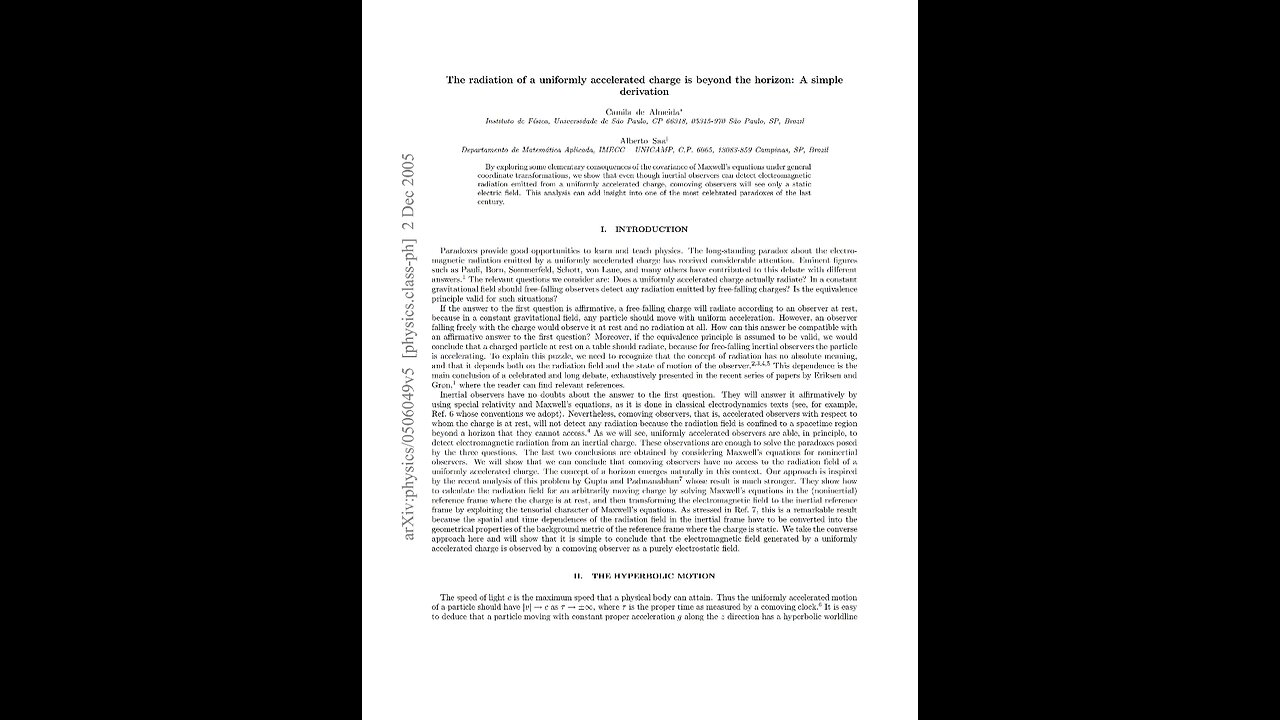Premium Only Content

The radiation of a uniformly accelerated charge: Camila de Almeida. A Puke (TM) Audiopaper
The radiation of a uniformly accelerated charge is beyond the horizon: A simple derivation.
Camila de Almeida.
Departamento de Matematica Aplicada, Campinas.
Instituto de Fısica, Universidade de Sao Paulo, Brazil.
By exploring some elementary consequences of the covariance of Maxwell’s equations under general coordinate transformations, we show that even though inertial observers can detect electromagnetic radiation emitted from a uniformly accelerated charge, co moving observers will see only a static electric field. This analysis can add insight into one of the most celebrated paradoxes of the last century.
One. Introduction.
Paradoxes provide good opportunities to learn and teach physics. The long-standing paradox about the electromagnetic radiation emitted by a uniformly accelerated charge has received considerable attention. Eminent figures such as Pauli, Born, Sommerfeld, Schott, von Laue, and many others have contributed to this debate with different answers. The relevant questions we consider are: Does a uniformly accelerated charge actually radiate? In a constant gravitational field should free-falling observers detect any radiation emitted by free-falling charges? Is the equivalence principle valid for such situations?
If the answer to the first question is affirmative, a free-falling charge will radiate according to an observer at rest, because in a constant gravitational field, any particle should move with uniform acceleration. However, an observer falling freely with the charge would observe it at rest and no radiation at all. How can this answer be compatible with an affirmative answer to the first question? Moreover, if the equivalence principle is assumed to be valid, we would conclude that a charged particle at rest on a table should radiate, because for free-falling inertial observers the particle is accelerating. To explain this puzzle, we need to recognize that the concept of radiation has no absolute meaning, and that it depends both on the radiation field and the state of motion of the observer. This dependence is the main conclusion of a celebrated and long debate, exhaustively presented in the recent series of papers by Eriksen and Gron, where the reader can find relevant references.
Inertial observers have no doubts about the answer to the first question. They will answer it affirmatively by using special relativity and Maxwell’s equations, as it is done in classical electrodynamics texts, see, for example Reference 6 whose conventions we adopt. Nevertheless, co-moving observers, that is, accelerated observers with respect to whom the charge is at rest, will not detect any radiation because the radiation field is confined to a space-time region beyond a horizon that they cannot access. As we will see, uniformly accelerated observers are able, in principle, to detect electromagnetic radiation from an inertial charge. These observations are enough to solve the paradoxes posed by the three questions. The last two conclusions are obtained by considering Maxwell’s equations for non-inertial observers. We will show that we can conclude that co moving observers have no access to the radiation field of a uniformly accelerated charge. The concept of a horizon emerges naturally in this context. Our approach is inspired by the recent analysis of this problem by Gupta and Padmanabhan whose result is much stronger. They show how to calculate the radiation field for an arbitrarily moving charge by solving Maxwell’s equations in the, non-inertial, reference frame where the charge is at rest, and then transforming the electromagnetic field to the inertial reference frame by exploiting the tensorial character of Maxwell’s equations. As stressed in Reference 7, this is a remarkable result because the spatial and time dependences of the radiation field in the inertial frame have to be converted into the geometrical properties of the background metric of the reference frame where the charge is static. We take the converse approach here and will show that it is simple to conclude that the electromagnetic field generated by a uniformly accelerated charge is observed by a co moving observer as a purely electrostatic field.
Two. The hyperbolic motion.
The speed of light c is the maximum speed that a physical body can attain. Thus the uniformly accelerated motion of a particle should have v goes to c as tau goes to plus or minus infinity where is the proper time as measured by a co-moving clock. It is easy to deduce that a particle moving with constant proper acceleration g along the z direction has a hyperbolic world-line given by the curve r alpha (Of tau):
Equations one-a to one-d, in the text. For example c t equals c squared over g times hyperbolic sine of g tau over c.
There is no loss of generality if the motion is restricted to the z direction. Such a world-line is displayed in Figure one.
“A.” The Horizons.
The velocity of a particle according to Equation one approaches plus or minus c as tau goes to plus or minus infinity, and its trajectory tends asymptotically to the lines plus or minus c t equals z, with z greater than zero as shown in Figure one.
Consider the point Q. Its past light-cone intersects the hyperbolic trajectory. Indeed, a large part of the trajectory, tau is less than tau Q ret, is entirely contained inside its past light-cone, implying that the point Q could be causally influenced by signals emitted by the particle for tau is less than or equal to tau Q ret.
No signal emitted for tau greater than tau Q ret will influence Q, because the points of the trajectory with tau greater than tau Q ret are not contained in the past light-cone of Q.
Moreover, a signal emitted in the space time Q will affect only the region corresponding to its future light-cone, implying that no signal emitted in Q will reach the particle moving according to Equation one.
The line ct equals z acts as a future event horizon for regions One and Four, or, equivalently, a past event horizon for regions Two and Three. No signal emitted in regions Two or Three will reach regions One and Four, although signals emitted in One or Four can cross the line and enter into regions Two and Three.
Analogously, the line minus c t equals is a future event horizon for regions three and four, or a past event horizon for one and two.
Because the hyperbolic trajectory is entirely contained in region One, the lines ct equals z and minus ct equals z act, respectively, as the future and past horizons for a particle under uniformly accelerated motion. We will see that such structures appear naturally when we consider the radiation emitted by a uniformly accelerated charged particle.
B. The Radiation in the inertial frame.
The metric of the inertial Minkowski spacetime is given by equation two:
D s squared equals eta “A”, “B” d x “A” d X “B” equals c squared d t squared minus d x squared minus d y squared minus d z squared.
Where x “A” equals ct, x, y, z. Maxwell’s equations are not only Lorentz invariant, they can also be cast in a generally covariant way, valid for any reference frame with the metric G “A”, “B”.
The derivative of the Faraday tensor, equation three.
D “A” of F B C plus D “B” of F C “A” plus D “C” of F “A” B equals zero.
And equation four, the derivative of the Faraday tensor equals the current density.
G equals the determinant of G “A” B, and J B is the external 4-current.
Equation three is automatically satisfied if the 4-potential “A” b is introduced: F b c equals d b of “A” c minus d c of “A” b.
In the inertial Minkowski frame, the radiation emitted by a uniformly accelerated charge e corresponds to the solution of Equations three and four with G “A” B equals eta “A” b.
The Current density J “A” (Of x) equals the integral of a single point charge.
Such a solution for the Faraday tensor is given by equation five, for the conditions of equation six.
In the inertial frame we can read from the Faraday tensor F “A”, “B” the usual three-dimensional components of the electric and magnetic field as equation eight, and obtain after some algebra the components of the electric and magnetic fields as in equations nine.
These are the electromagnetic fields due to a uniformly accelerated charge moving according to Equation one.
The radiation content can be extracted by separating the components that drop off as one over R from the usual Coulomb one over r squared fields. As shown in Figure one, only regions One and Two can experience the fields in Equation nine. The main conclusion of Reference four is that, even though radiation components are present in both regions, only observations performed in region Two, and, perhaps, also on the boundary ct equals z between regions One and Two, would allow us to detect unambiguously the radiation emitted by the charge. This conclusion implies that the co-moving observer would not detect any radiation at all, because region Two is inaccessible to uniformly accelerated observers. Although this conclusion is correct, its logical derivation is involved and not intuitive. Two regions of space-time which have qualitatively distinct behavior for the radiation field according to inertial observers are identified and, then, it is shown that the co-moving observers have access only to the region where inertial observers are not able to detect any radiation field. However, this conclusion does not directly imply that the co-moving observers cannot detect the radiation because, as we have discussed, the detection of radiation has no absolute meaning because the detection depends both on the radiation field and the state of motion of the observer.
C. No Radiation in the co-moving frame.
We can show directly that a co-moving observer will observe the fields in Equation nine as a static electric field. The reference frame of a uniformly accelerated observer corresponds to the Rindler space-time, which in our case is spanned by the co-ordinates x prime a (Of x) equals c tau (Of t, z), x, y, Xi (OF t, z) defined by equation ten.
T equals the square root of two xi over g times shine g tau over c.
And z equals c times square root two xi over g times gosh g tau over c.
With Xi greater than zero.
The particle under the hyperbolic motion of equations one in the Rindler reference frame is at rest at xi equals c squared over two g, and its proper time is measured by tau. In these coordinates the spacetime interval is given by:
D s squared equals G “A”, “B” d x “A”, d x “B”.
Note that the coordinates defined by Equation ten cover only region One of the original Minkowski spacetime. Because static observers, where Xi is a constant, correspond to uniformly accelerating observers in the original Minkowski spacetime, their velocity in the inertial frame will approach c as tau goes to infinity, implying that no signal coming from region Two will ever reach them see Figure one.
As mentioned, the line c t equals z behaves as an event horizon, and no signal emitted in regions two or three can escape into regions one and four.
The coordinate transformation, ten, can be used to obtain the solution of Maxwell’s equations, three and four for the Rindler spacetime with a charge e at rest in Xi equals c squared over two g.
Recall that the electromagnetic field F “A”, “B” is a tensor and hence under a coordinate transformation x “A” goes to X “A” prime it transforms as equation twelve.
Because Maxwell’s equations (3) and (4) are covariant under general coordinate transformations, F prime “A”, “B” will be a solution for the coordinate system x prime “A” (Of x) if the Faraday tensor F “A” “B” is a solution of Equations three and four in the coordinate system x “A”. The magnetic components of F prime “A”, “B” are given by equation set thirteen.
Strictly speaking, we need to be careful about the interpretation of F prime 1, 3 F prime 2, 3 and F prime 1, 2 as the components of the magnetic field as observed in the Rindler reference frame. A proper definition of electric and magnetic fields for non-inertial reference frames can be obtained from the Lorentz force formula. This issue will not be relevant to our analysis.
By using equation nine, the components of the faraday tensor can be written down, as in equation fourteen.
From the equations ten, which relate the transformation between proper time tau and rest frame time t, we can calculate.
D tau, d t equals z over two xi.
D tau, d z equals minus t over two xi.
D xi, d t equals minus g t.
D xi, d z equals g z over c squared.
This leads to F prime 1,3 equals F prime 2,3 equals zero. Therefore the only non-vanishing components of the electromagnetic field experienced by Co-moving observers are F prime 0-1, 0-2 and 0-3. Because the only non-vanishing component of the 4-current J rime “A” is J prime zero for a static charge in the Rindler reference frame, we conclude from Equation four that the remaining non-vanishing components of the electromagnetic field are static, that is,
d F prime zero one, with respect to 0, equals
d F prime zero two, with respect to 0, equals
d F prime zero three, with respect to 0, equals zero.
So that there is no radiation field in region one, the Rindler reference frame.
This result answers our question.
A co-moving observer will not detect any radiation from a uniformly accelerated charge. The co-moving observer can receive signals only from regions one and four. The field emitted by the accelerated charge does not reach region four, and in region one, it is interpreted by the co-moving observer as a static field. We note that essentially the same argument was used by Rohrlich to show that in a static homogeneous gravitational field, static observers do not detect any radiation from static charges.
The situation is qualitatively different beyond the horizon in region two. Although uniformly accelerated observers will never receive any information from region two, they can affect this region. The coordinate system ten can be extended to include region two by considering Xi is less than zero and the equation set sixteen.
T, and z are expressible using transformations of the hyperbolic cos and sine of the proper time.
The metric eleven and the expressions fifteen, valid for region one, also hold in region two, but with a crucial difference due to the change of sign of the metric components: in region two, xi instead of tau plays the role of a time parameter.
Thus the metric of equation eleven is not static in region two. The magnetic components of F prime “A”, “B” in region two can be obtained from transformations such as Equation thirteen if we take into account that the components zero, temporal, and three, spatial are, respectively, Xi and c tau in equation seventeen:
One over y F prime 1, 3 equals one over x F prime 2, 3 equals the charge e over a function of tau, z and t.
The fields in equation seventeen, together with the electric components that can be obtained in an analogous way, are time-dependent solutions of the, vacuum, Maxwell equations in region two, having radiating parts. However, they are inaccessible to a co-moving observer because they are confined beyond his-her future horizon.
Three. CONCLUDING REMARKS.
The physics of the Rindler space is sufficiently subtle to deserve some extra remarks. Trajectories with constant Xi, see Figure two, correspond to uniformly accelerated trajectories in the inertial frame, but with distinct accelerations.
The trajectory one corresponds to the static world-line Xi equals c squared over two g in the Rindler frame. From the inertial frame point of view, the true co-moving observer should correspond also to xi equals c squared over two g, because any other static Rindler observer would be in relative motion according to the inertial frame point of view with respect to the charge following Equation one.
Our results show that the electromagnetic field of the uniformly accelerated charge is realized as a purely electrostatic field everywhere in the Rindler frame, implying that even observers with Xi is not equals c squared over two g, for which the charge is indeed accelerating when observed from the inertial point of view, would not detect the emitted radiation. This observation, which anticipates an intriguing quantum result described by Matsas, reinforces the role played by the horizon, the unique property that the trajectories of these distinct observers have in common, see figure two.
The discussion can be considerably enriched by the introductions of quantum mechanical concepts. The classical radiation emitted by the accelerated charge in the inertial frame consists of a large number of real photons, which due to some subtle quantum effects cannot be detected by co-moving observers. To illustrate the novelties brought by quantum mechanics, consider in the Minkowski space a uniformly accelerated observer following a trajectory such as that in Equation one and a charge at rest at the origin. The world-line for this charge is the ct axis, and it is restricted to regions two and four. The solution of Maxwell equations in the inertial frame is the static Coulomb field is given in equation eighteen.
Which spreads over all four regions of Figure one. In region one, where a uniformly accelerated observer can detect any field coming from the charge, the static Coulomb field will be measured by such observers as a time-depending electromagnetic field with components given in equation nineteen.
The fields nineteen are solutions of the, vacuum, Maxwell equations in region one as seen by uniformly accelerated observers.
These fields have radiative components, although it is not so easy in this case to identify the terms dropping off as one over R. Note that the accelerated observers are completely unaware of the charge fate in region two. Because they can detect only the contributions coming from regions one and four, they will never discover what eventually happens to the charge in region two if it, for instance, accelerates or even if it vanishes.
An analysis of this problem based on quantum field theory, however, demands that the trajectory of the charge be entirely inside region one. Is it possible to conclude something in this case? Astonishing the answer is yes. In the Rindler reference frame static trajectories with Xi goes to infinity, see Figure two 2, correspond to uniformly accelerated trajectories in the inertial frame, restricted by construction to region one, but with proper acceleration g equals c squared over two Xi goes to zero. Thus, they correspond to inertial trajectories! Now we can answer the question of whether uniformly accelerated observers could detect any photon emitted by these specific inertial charges, and the answer is no.
The detection of radiation is not the only paradox involving accelerated charges. Another very interesting paradox is related to the radiation reaction force. As we discussed, an inertial observer detects the radiation emitted by a uniformly accelerated charge.
He-she can even calculate the, non-vanishing, total radiated power. But we know from classical electrodynamics that the radiation reaction force vanishes for a constant proper acceleration. Hence, what is acting as the source of the radiated power? How is it possible to conserve energy in this case? Interesting questions, but that’s another story.
Figure One. The hyperbolic trajectory r “A” (Of tau) given by Equation one. The retarded time tau ret associated with a given point (c t, x, y, z) corresponds to the (unique) intersection of the past light-cone of (c t, x, y, z) with the trajectory r “A” (Of tau). For instance,
Q prime equals c squared over g times shine g tau ret Q over C, zero, zero gosh g tau ret Q over C, and
P prime equals c squared over g times shine g tau ret P over C, zero, zero gosh g tau ret P over C,
define, respectively, the retarded times tau ret Q and tau ret P associated with the points Q and P.
The future light-cone is the boundary of the causal future of a given point.
Thus, any event occurring, for instance, in the spacetime point R will affect only the region enclosed by its future light-cone, with the light-cone surface reserved only to signals moving with velocity c. Note that only regions one and two are affected by the fields due to a charged particle with a world line given by Equation one.
Figure two. The lines of constant Xi and tau according to Equation ten and sixteen, respectively, for the regions one and two.
In region one, the Rindler frame where Xi is greater than zero, the identified lines correspond to Xi 1 less than Xi 2 is less than Xi three and tau 1 is less than tau 2 is less than tau three.
Lines of constant Xi, the hyperbola, are time-like. On the other hand, for region two, known as the Milne frame where Xi is less than zero, the lines of constant tau are time like.
The identified lines in two correspond to the cases tau 1 is less than tau 2 is less than tau and Xi 1 is greater than Xi 2 is greater than Xi 3. The horizon, the boundary c t equals z between one and two, corresponds to one half of the degenerated hyperbola corresponding to Xi equals zero.
https://rumble.com/v3t4yzj-index-of-science.-music-by-dan-vasc.html
-
 55:37
55:37
Candace Show Podcast
5 hours agoMatt Gaetz Out, Jussie Smollett Walks Free! | Candace Ep 108
121K273 -
 54:43
54:43
LFA TV
23 hours agoTrump Has Learned His Lesson | Trumpet Daily 11.21.24 7PM EST
24.2K4 -

theDaily302
12 hours agoThe Daily 302-Special Border Invasion Shutdown Show
14.7K -
 4:29:05
4:29:05
Tate Speech by Andrew Tate
13 hours agoEMERGENCY MEETING EPISODE 92 - IN THE TRENCHES
748K1.13K -
 1:01:23
1:01:23
In The Litter Box w/ Jewels & Catturd
1 day agoThe Trump Effect | In the Litter Box w/ Jewels & Catturd – Ep. 696 – 11/21/2024
89.2K33 -
 20:53
20:53
SLS - Street League Skateboarding
2 days agoGold Medals, World Class Food, Night life & more - Get Lost: Tokyo
81K7 -
 47:13
47:13
PMG
21 hours ago $1.26 earned"Hannah Faulkner and Doug Billings | WHY LIBERALS LOST THE ELECTION"
41.9K1 -
 59:01
59:01
The Liberty Lobbyist
7 hours ago"We Only Have NOW To Make a Difference"
42K2 -
 4:16:41
4:16:41
CatboyKami
8 hours agoStalker 2 Blind playthrough pt1
43.4K2 -
 1:06:27
1:06:27
Russell Brand
9 hours agoNeil Oliver on the Rise of Independent Media, Cultural Awakening & Fighting Centralized Power –SF498
214K289